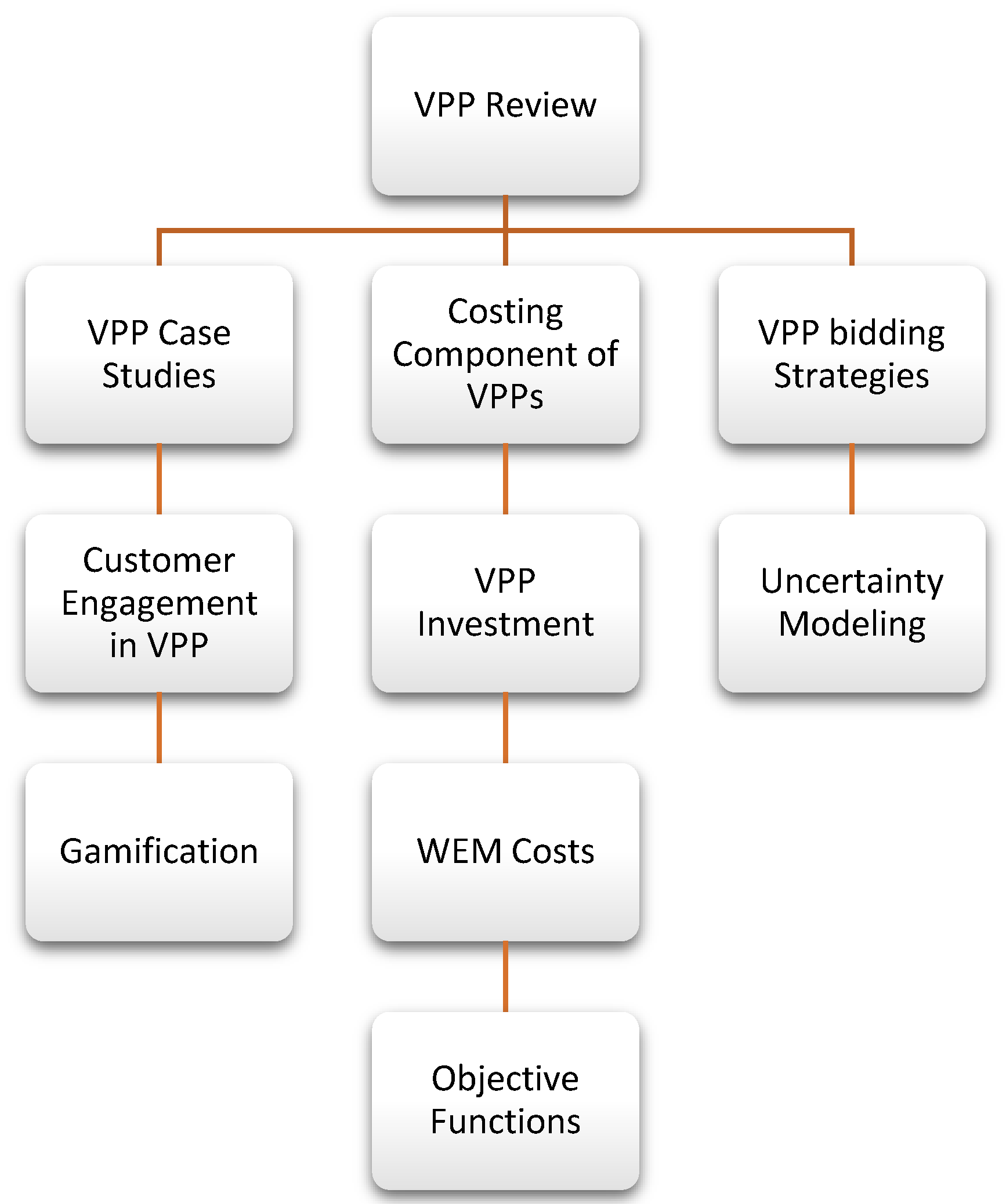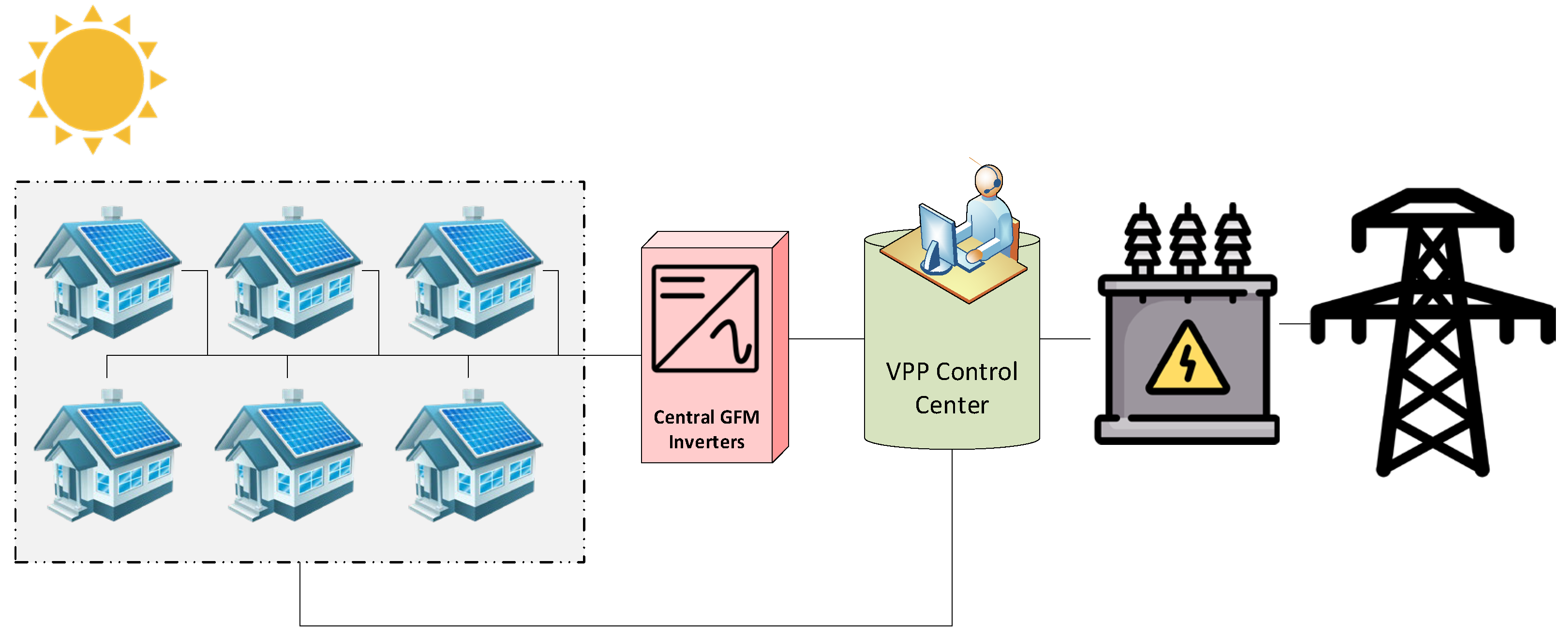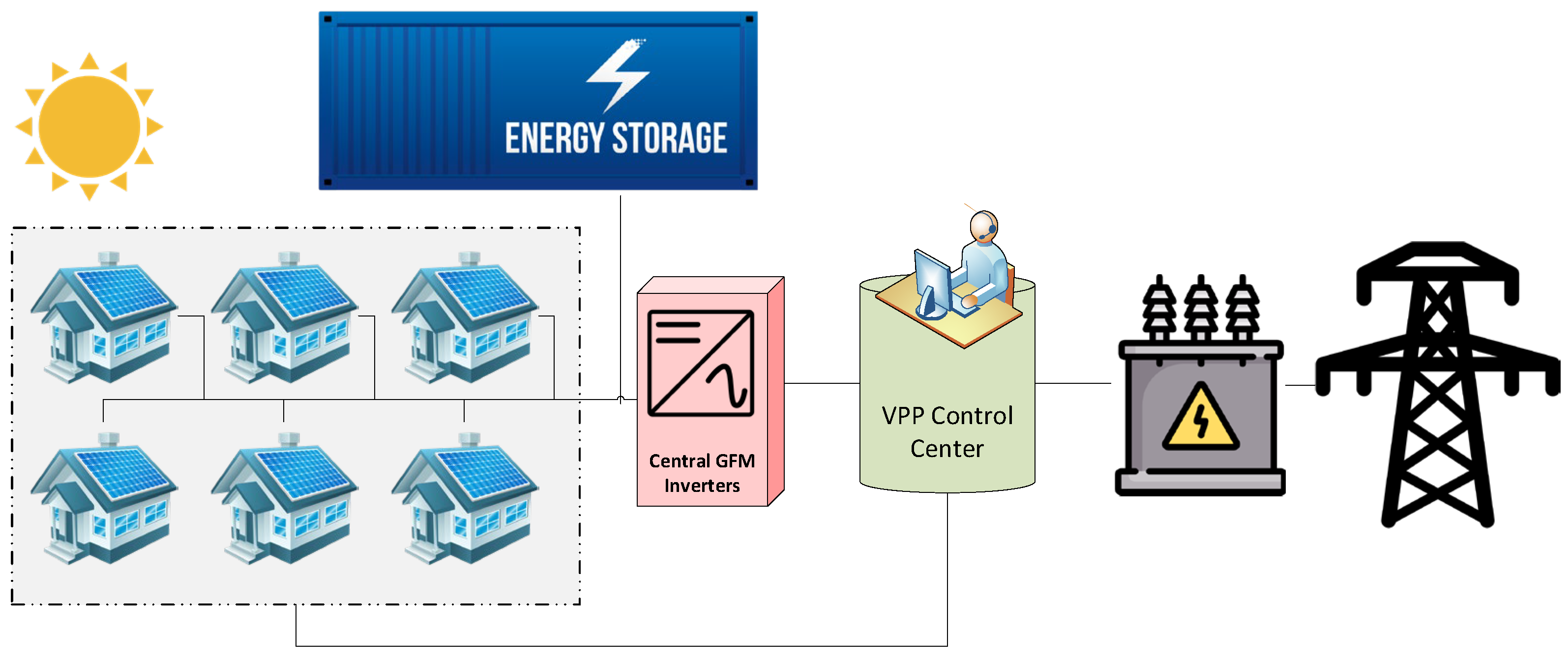Virtual Power Plants (VPPs) are efficient structures for attracting private investment, increasing the penetration of renewable energy and reducing the cost of electricity for consumers. It is expected that the number of VPPs will increase rapidly as their financial return is attractive to investors. VPPs will provide added value to consumers, to power systems and to electricity markets by contributing to different services such as the energy and load-following services. Grid forming inverters (GFM) are used to connect distributed energy sources and devices into a unique resource and convert it to Alternating Current. GFMs are especially suited to connecting VPPs to the main power grid.
- virtual power plant
- grid-forming inverters
- renewable energy
1. Introduction
2. Virtual Power Plants (VPPs)
2.1. General Overview

2.2. VPP Case Studies
| Ref. # | DR | PVs | Energy Storage | Heat Pump | Electricity Market | Detailed Modelling | Gamified DR | WA Context |
|---|---|---|---|---|---|---|---|---|
| [15] | × | √ | × | × | √ | √ | × | × |
| [16] | √ | √ | √ | √ | √ | × | × | × |
| [17] | √ | √ | √ | × | √ | × | × | × |
| [18] | √ | √ | √ | √ | × | × | × | × |
| [19] | √ | √ | √ | × | √ | × | × | × |
| [20] | × | √ | × | × | √ | √ | × | × |
| [21] | √ | √ | √ | √ | √ | × | × | × |
| [22] | √ | √ | √ | × | √ | × | × | × |
| [23] | √ | √ | √ | √ | √ | × | × | × |
| [24] | √ | √ | √ | × | √ | √ | × | × |
| [25] | √ | √ | √ | × | √ | × | × | × |
| [26] | √ | √ | √ | √ | × | √ | × | × |
| [27] | × | √ | √ | × | × | √ | × | × |
| [28] | × | √ | √ | × | √ | √ | × | √ |
-
Participation in the electricity market to provide different services such as energy and ancillary services such as frequency regulation and grid voltage control;
-
Provision of operational visibility for better understanding of VPPs’ benefits;
-
Enhancement of customer satisfaction and experience;
-
Evaluation of the requirement of cyber security.
2.3. Customer Engagement in VPPs
2.4. Gamification
3. Concept of a Grid-Forming VPP



This entry is adapted from the peer-reviewed paper 10.3390/en15239049
References
- Olabi, A.; Abdelkareem, M.A. Renewable energy and climate change. Renew. Sustain. Energy Rev. 2022, 158, 112111.
- Wang, W.; Huang, Y.; Yang, M.; Chen, C.; Zhang, Y.; Xu, X. Renewable energy sources planning considering approximate dynamic network reconfiguration and nonlinear correlations of uncertainties in distribution network. Int. J. Electr. Power Energy Syst. 2022, 139, 107791.
- Mozafar, M.R.; Moradi, M.H.; Amini, M.H. A simultaneous approach for optimal allocation of renewable energy sources and electric vehicle charging stations in smart grids based on improved GA-PSO algorithm. Sustain. Cities Soc. 2017, 32, 627–637.
- Jamil, E.; Hameed, S.; Jamil, B.; Qurratulain. Power quality improvement of distribution system with photovoltaic and permanent magnet synchronous generator based renewable energy farm using static synchronous compensator. Sustain. Energy Technol. Assess. 2019, 35, 98–116.
- Jafari, A.; Khalili, T.; Ganjehlou, H.G.; Bidram, A. Optimal integration of renewable energy sources, diesel generators, and demand response program from pollution, financial, and reliability viewpoints: A multi-objective approach. J. Clean. Prod. 2019, 247, 119100.
- Malekpour, A.R.; Pahwa, A. A Dynamic Operational Scheme for Residential PV Smart Inverters. IEEE Trans. Smart Grid 2016, 8, 2258–2267.
- Vahedipour-Dahraie, M.; Rashidizadeh-Kermani, H.; Shafie-Khah, M.; Catalao, J.P.S. Risk-Averse Optimal Energy and Reserve Scheduling for Virtual Power Plants Incorporating Demand Response Programs. IEEE Trans. Smart Grid 2021, 12, 1405–1415.
- Sikorski, T.; Jasiński, M.; Ropuszyńska-Surma, E.; Węglarz, M.; Kaczorowska, D.; Kostyla, P.; Leonowicz, Z.; Lis, R.; Rezmer, J.; Rojewski, W.; et al. A Case Study on Distributed Energy Resources and Energy-Storage Systems in a Virtual Power Plant Concept: Technical Aspects. Energies 2020, 13, 3086.
- CER 2020 Large-Scale Renewable Energy Target Capacity Achieved. Available online: http://www.cleanenergyregulator.gov.au/RET/Pages/News and updates/NewsItem.aspx?ListId=19b4efbb-6f5d-4637-94c4-121c1f96fcfe&ItemId=683 (accessed on 4 September 2019).
- COAG Renewable Energy Target Scheme Design. Available online: https://www.coag.gov.au/node/219 (accessed on 29 June 2022).
- Dulau, L.I.; Abrudean, M.; Bica, D. Distributed Generation and Virtual Power Plants. In Proceedings of the Universities Power Engineering Conference; IEEE Computer Society, Cluj-Napoca, Romania, 2–5 September 2014.
- Ghavidel, S.; Li, L.; Aghaei, J.; Yu, T.; Zhu, J. A Review on the Virtual Power Plant: Components and Operation Systems. In Proceedings of the 2016 IEEE International Conference on Power System Technology, Powercon 2016, Wollongong, NSW, Australia, 28 September–1 October 2016; pp. 1–6.
- Abdolrasol, M.G.M.; Hannan, M.A.; Mohamed, A.; Amiruldin, U.A.U.; Abidin, I.B.Z.; Uddin, M.N. An Optimal Scheduling Controller for Virtual Power Plant and Microgrid Integration Using the Binary Backtracking Search Algorithm. IEEE Trans. Ind. Appl. 2018, 54, 2834–2844.
- Behi, B.; Jennings, P.; Arefi, A.; Pivrikas, A. Bidding Strategy for a Virtual Power Plant for Trading Energy in the Wholesale Electricity Market-Murdoch University Research Repository. Available online: https://researchrepository.murdoch.edu.au/id/eprint/65657/ (accessed on 21 November 2022).
- Li, Y.; Gao, W.; Ruan, Y. Feasibility of virtual power plants (VPPs) and its efficiency assessment through benefiting both the supply and demand sides in Chongming country, China. Sustain. Cities Soc. 2017, 35, 544–551.
- Wang, H.; Riaz, S.; Mancarella, P. Integrated techno-economic modeling, flexibility analysis, and business case assessment of an urban virtual power plant with multi-market co-optimization. Appl. Energy 2019, 259, 114142.
- Lehmbruck, L.; Kretz, J.; Aengenvoort, J.; Sioshansi, F. Aggregation of Front-and behind-the-Meter: The Evolving VPP Business Model. In Behind and beyond the Meter: Digitalization, Aggregation, Optimization, Monetization; Sioshansi, F., Ed.; Academic Press: Cambridge, MA, USA, 2020; pp. 211–232. ISBN 9780128199510.
- German virtual power plant project using 25 BlueGen mCHP units. Fuel Cells Bull. 2012, 2012, 4.
- van Summeren, L.F.; Wieczorek, A.J.; Bombaerts, G.J.; Verbong, G.P. Community energy meets smart grids: Reviewing goals, structure, and roles in Virtual Power Plants in Ireland, Belgium and the Netherlands. Energy Res. Soc. Sci. 2019, 63, 101415.
- Elgamal, A.H.; Kocher-Oberlehner, G.; Robu, V.; Andoni, M. Optimization of a multiple-scale renewable energy-based virtual power plant in the UK. Appl. Energy 2019, 256, 113973.
- Dietrich, K.; Latorre-Canteli, J.M.; Olmos, L.; Ramos, A. Modelling and assessing the impacts of self-supply and market-revenue driven Virtual Power Plants. Electr. Power Syst. Res. 2015, 119, 462–470.
- Parag, Y.; Ainspan, M. Sustainable microgrids: Economic, environmental and social costs and benefits of microgrid deployment. Energy Sustain. Dev. 2019, 52, 72–81.
- Moreno, B.; Díaz, G. The impact of virtual power plant technology composition on wholesale electricity prices: A comparative study of some European Union electricity markets. Renew. Sustain. Energy Rev. 2018, 99, 100–108.
- Loßner, M.; Böttger, D.; Bruckner, T. Economic assessment of virtual power plants in the German energy market—A scenario-based and model-supported analysis. Energy Econ. 2017, 62, 125–138.
- Magdy, F.E.Z.; Ibrahim, D.K.; SABRY, W. Virtual Power Plants Modeling and Simulation using Innovative Electro-Economical Concept. In Proceedings of the 2019 16th Conference on Electrical Machines, Drives and Power Systems (ELMA), Varna, Bulgaria, 6–8 June 2019; pp. 1–5.
- Veilleux, G.; Potisat, T.; Pezim, D.; Ribback, C.; Ling, J.; Krysztofiński, A.; Ahmed, A.; Papenheim, J.; Pineda, A.M.; Sembian, S.; et al. Techno-economic analysis of microgrid projects for rural electrification: A systematic approach to the redesign of Koh Jik off-grid case study. Energy Sustain. Dev. 2019, 54, 1–13.
- AEMO Virtual Power Plant (VPP) Demonstrations. Available online: https://aemo.com.au/initiatives/major-programs/nem-distributed-energy-resources-der-program/pilots-and-trials/virtual-power-plant-vpp-demonstrations (accessed on 1 February 2022).
- Synergy Schools VPP Pilot Project. Available online: https://www.synergy.net.au/Our-energy/For-tomorrow/Schools-VPP-Pilot-Project (accessed on 1 February 2022).
- Synergy Project Symphony. Available online: https://www.synergy.net.au/Our-energy/For-tomorrow/Project-Symphony (accessed on 30 September 2022).
- AEMO Data Dashboard for Live Market Prices. Available online: https://www.aemo.com.au/Electricity/Wholesale-Electricity-Market-WEM/Data-dashboard(live) (accessed on 24 November 2022).
- AlSkaif, T.; Lampropoulos, I.; Broek, M.V.D.; van Sark, W. Gamification-based framework for engagement of residential customers in energy applications. Energy Res. Soc. Sci. 2018, 44, 187–195.
- Hadayeghparast, S.; Farsangi, A.S.; Shayanfar, H. Day-ahead stochastic multi-objective economic/emission operational scheduling of a large scale virtual power plant. Energy 2019, 172, 630–646.
- Al-Awami, A.T.; Amleh, N.A.; Muqbel, A.M. Optimal Demand Response Bidding and Pricing Mechanism with Fuzzy Optimization: Application for a Virtual Power Plant. IEEE Trans. Ind. Appl. 2017, 53, 5051–5061.
- Farsangi, A.S.; Hadayeghparast, S.; Mehdinejad, M.; Shayanfar, H. A novel stochastic energy management of a microgrid with various types of distributed energy resources in presence of demand response programs. Energy 2018, 160, 257–274.
- Raoofat, M.; Saad, M.; Lefebvre, S.; Asber, D.; Mehrjedri, H.; Lenoir, L. Wind power smoothing using demand response of electric vehicles. Int. J. Electr. Power Energy Syst. 2018, 99, 164–174.
- Nguyen, H.T.; Le, L.B.; Wang, Z. A Bidding Strategy for Virtual Power Plants with the Intraday Demand Response Exchange Market Using the Stochastic Programming. IEEE Trans. Ind. Appl. 2018, 54, 3044–3055.
- Tang, W.-J.; Yang, H.-T. Optimal Operation and Bidding Strategy of a Virtual Power Plant Integrated with Energy Storage Systems and Elasticity Demand Response. IEEE Access 2019, 7, 79798–79809.
- Dabbagh, S.R.; Sheikh-El-Eslami, M.K. Participation of Demand Response Resources through Virtual Power Plant: A Decision Framework under Uncertainty. In Proceedings of the 2015 IEEE 15th International Conference on Environment and Electrical Engineering (EEEIC), Rome, Italy, 10–13 June 2015; pp. 2045–2049.
- Nosratabadi, S.M.; Hooshmand, R.-A.; Gholipour, E. Stochastic profit-based scheduling of industrial virtual power plant using the best demand response strategy. Appl. Energy 2016, 164, 590–606.
- Royapoor, M.; Pazhoohesh, M.; Davison, P.J.; Patsios, C.; Walker, S. Building as a virtual power plant, magnitude and persistence of deferrable loads and human comfort implications. Energy Build. 2020, 213, 109794.
- Arefi, A.; Abeygunawardana, A.; Ledwich, G. A New Risk-Managed Planning of Electric Distribution Network Incorporating Customer Engagement and Temporary Solutions. IEEE Trans. Sustain. Energy 2016, 7, 1646–1661.
- Liang, H.; Ma, J. Data-Driven Resource Planning for Virtual Power Plant Integrating Demand Response Customer Selection and Storage. IEEE Trans. Ind. Inform. 2021, 18, 1833–1844.
- Wang, Y.; Ai, X.; Tan, Z.; Yan, L.; Liu, S. Interactive Dispatch Modes and Bidding Strategy of Multiple Virtual Power Plants Based on Demand Response and Game Theory. IEEE Trans. Smart Grid 2015, 7, 510–519.
- Albertarelli, S.; Fraternali, P.; Herrera, S.; Melenhorst, M.; Novak, J.; Pasini, C.; Rizzoli, A.-E.; Rottondi, C. A Survey on the Design of Gamified Systems for Energy and Water Sustainability. Games 2018, 9, 38.
- Peham, G.; Michalczuk, R.M.B. The ecoGator App: Gamification for Enhanced Energy Efficiency in Europe. In Proceedings of the Second International Conference on Technological Ecosystems for Enhancing Multiculturality, Salamanca, Spain, 1 October 2014; ACM: New York, NY, USA; pp. 179–183.
- Lee, Y.; Brewer, R.S.; Johnson, P.M. Makahiki: An Open Source Game Engine for Energy Education and Conservation; Department of Information and Computer Sciences, University of Hawaii: Honolulu, HI, USA, 2012.
- Reeves, B.; Cummings, J.J.; Scarborough, J.K.; Flora, J.; Anderson, D. Leveraging the Engagement of Games to Change Energy Behavior. In Proceedings of the 2012 International Conference on Collaboration Technologies and Systems (CTS), Denver, CO, USA, 21–25 May 2012; IEEE: Piscataway, NJ, USA, 2012; pp. 354–358.
- Madeira, R.N.; Silva, A.; Santos, C.; Teixeira, B.; Romão, T.; Dias, E.; Correia, N. LEY!: Persuasive Pervasive Gaming on Domestic Energy Consumption-Awareness. In Proceedings of the 8th International Conference on Advances in Computer Entertainment Technology, Lisbon, Portugal, 8 November 2011; ACM: New York, NY, USA, 2011; p. 72.
- Foster, D.; Blythe, M.; Cairns, P. Wattsup?: Motivating Reductions in Domestic Energy Consumption Using Social Networks. In Proceedings of the 6th Nordic Conference on Human-Computer Interaction: Extending Boundaries, Reykjavik, Iceland, 16 October 2010; ACM: New York, NY, USA, 2010; pp. 178–187.
- Fraternali, S.; Novak, J.; Melenhorst, M.; Tzovaras, D.; Krinidis, S.; Rizzoli, A.E.; Rottondi, C.; Cellina, F. enCOMPASS—An Integrative Approach to Behavioural Change for Energy Saving. In Proceedings of the 2017 Global Internet of Things Summit (GIoTS), Geneva, Switzerland, 6 June 2017; IEEE: Piscataway, NJ, USA, 2017; pp. 1–6.
- Fraternali, P.; Cellina, F.; Herrera, S.; Krinidis, S.; Pasini, C.; Rizzoli, A.E.; Rottondi, C.; Tzovaras, D. A Socio-Technical System Based on Gamification Towards Energy Savings. In Proceedings of the 2018 IEEE International Conference on Pervasive Computing and Communications Workshops (PerCom Workshops), Athens, Greece, 19–23 March 2018; pp. 59–64.
- Gawhade, P.; Ojha, A. Recent advances in synchronization techniques for grid-tied PV system: A review. Energy Rep. 2021, 7, 6581–6599.
- Mahery, H.M.; Babaei, E. Mathematical modeling of buck–boost dc–dc converter and investigation of converter elements on transient and steady state responses. Int. J. Electr. Power Energy Syst. 2013, 44, 949–963.
- Scarabelot, L.T.; Rambo, C.R.; Rampinelli, G. A relative power-based adaptive hybrid model for DC/AC average inverter efficiency of photovoltaics systems. Renew. Sustain. Energy Rev. 2018, 92, 470–477.
